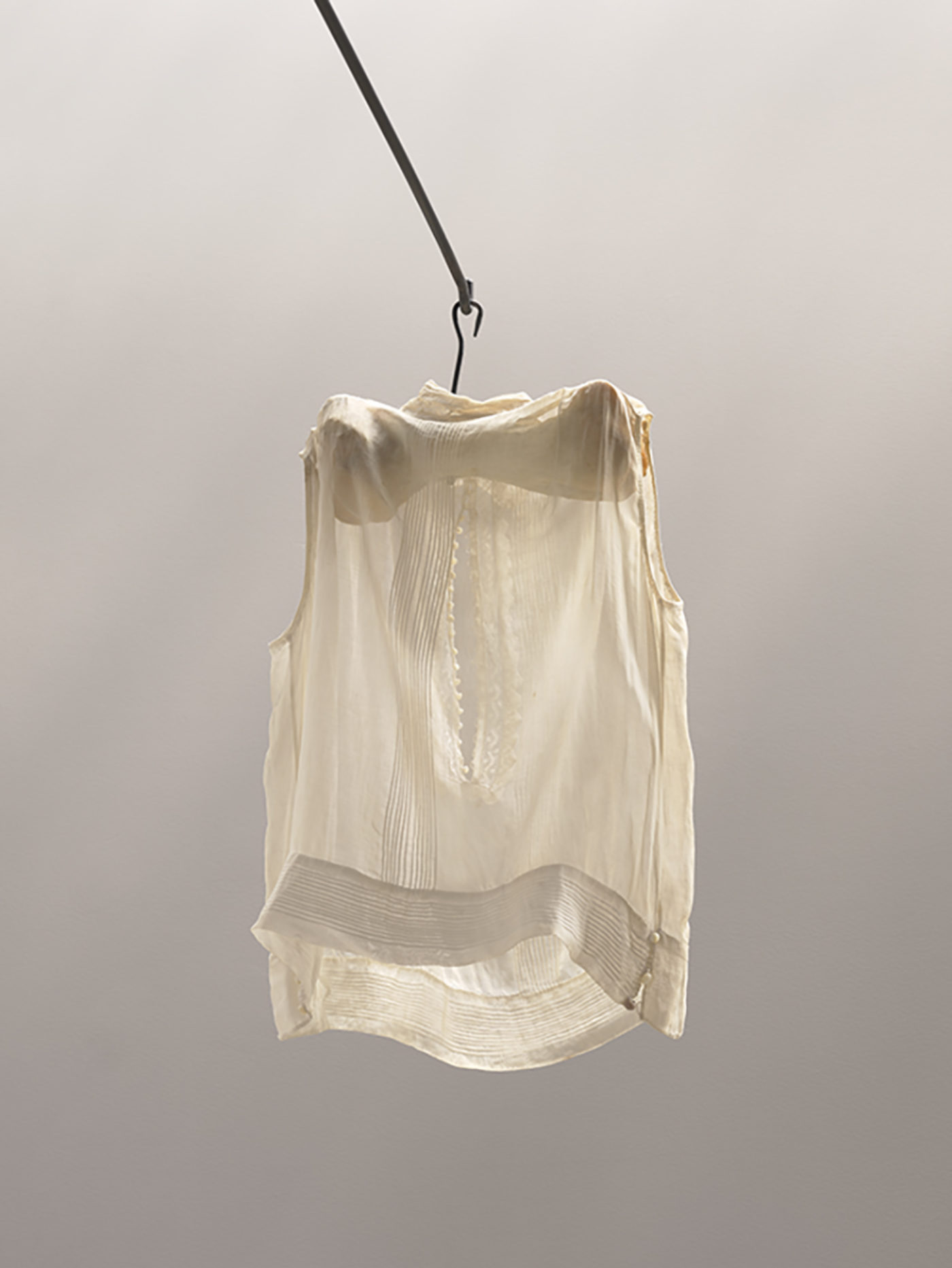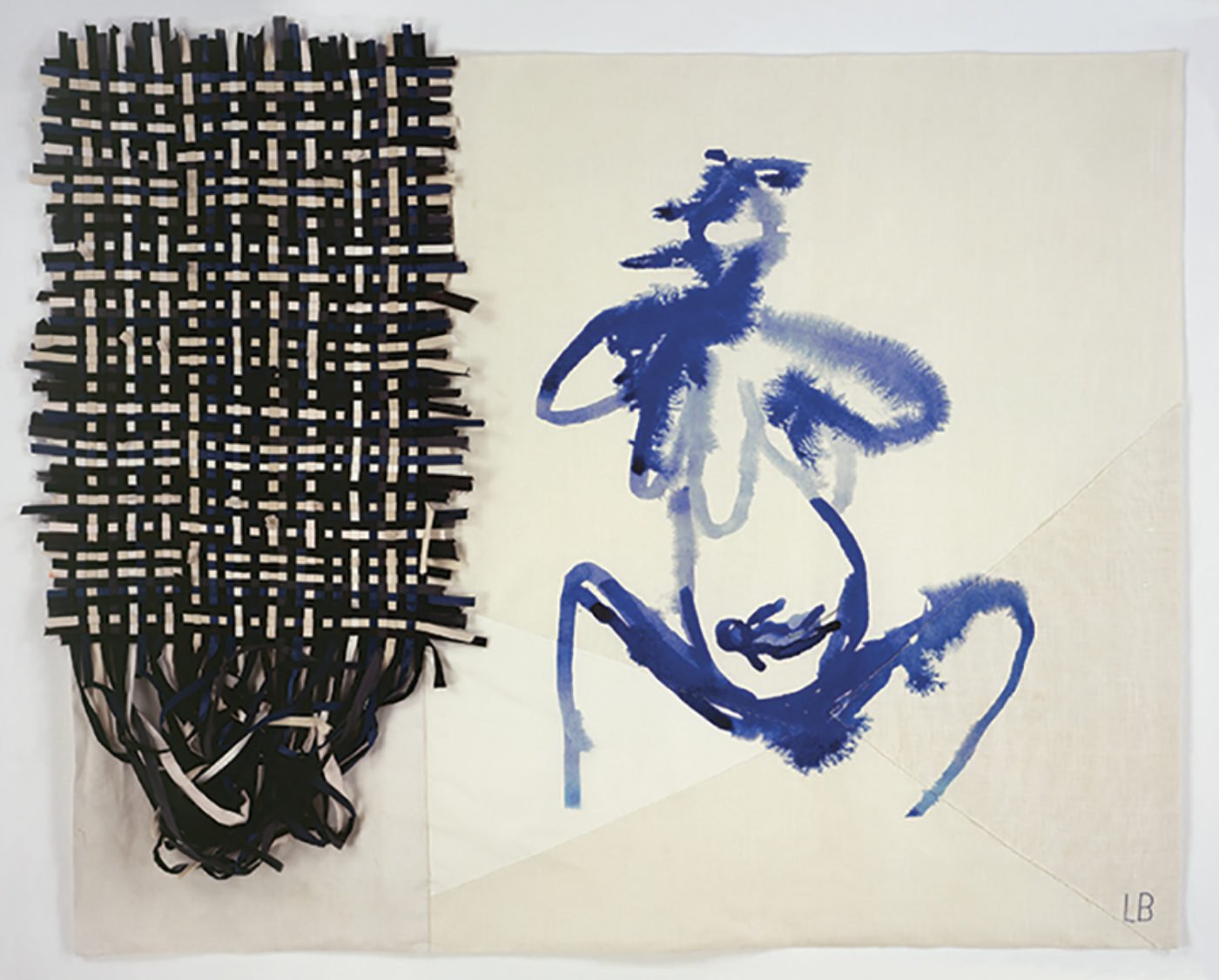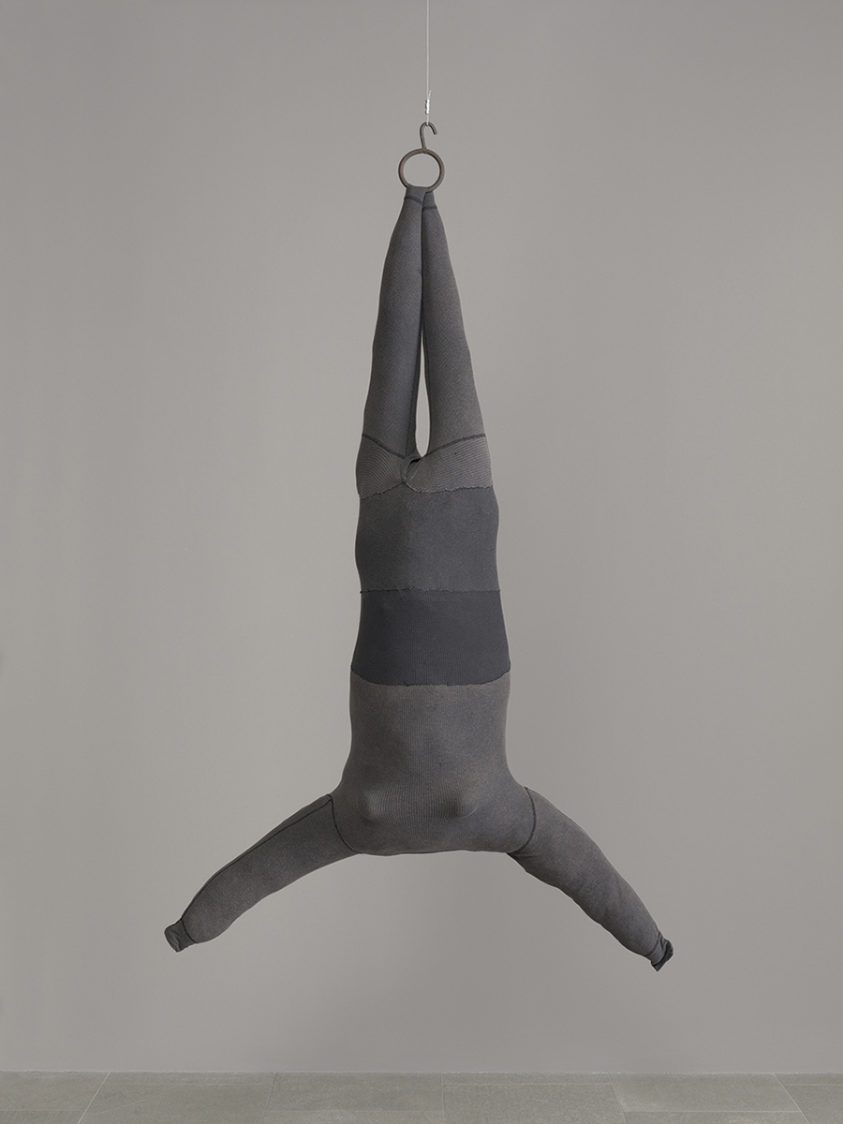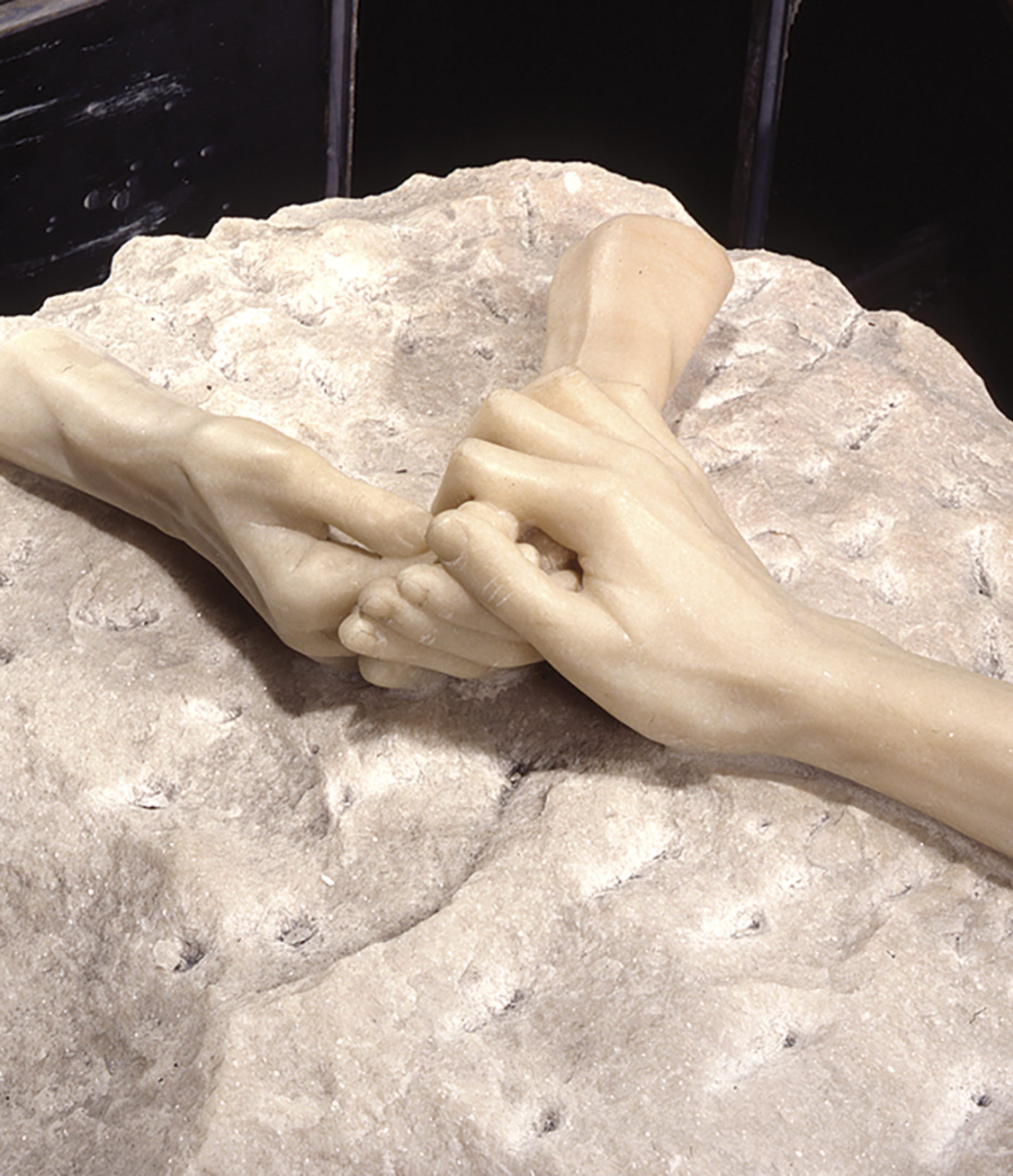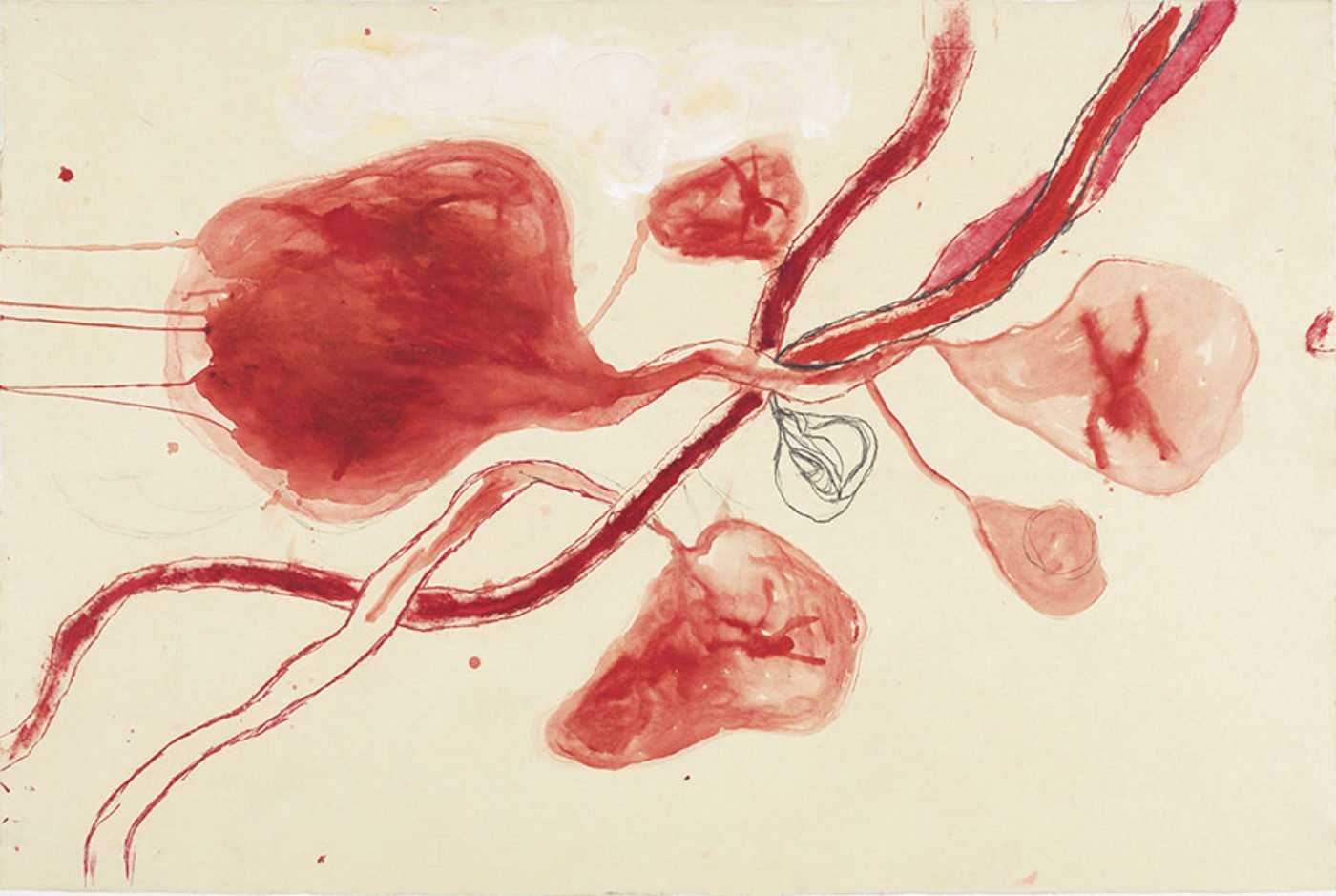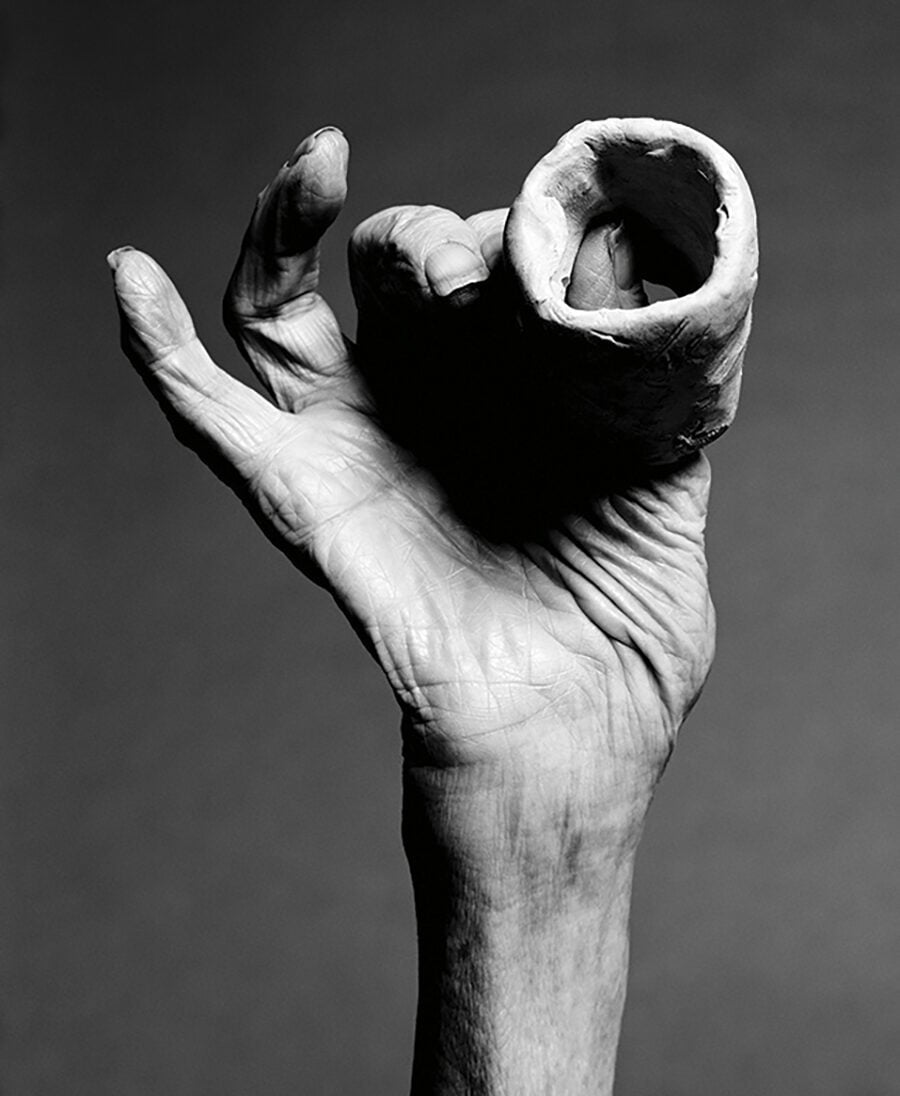
Photograph of Louise Bourgeois, 2002, by Holger Keifel © The artist
Discussed in this essay:
Louise Bourgeois: The Woven Child, edited by Ralph Rugoff. Hatje Cantz. 208 pages. $48.
The Artist’s Studio: A Century of the Artist’s Studio 1920–2020, edited by Iwona Blazwick. Whitechapel Gallery. 288 pages. $45.

The Insomnia Drawings, 1994–1995, two of 220 mixed-media artworks on paper. Courtesy the collection of the Easton Foundation, New York. Unless otherwise noted, all artwork is by Louise Bourgeois and photographed by Christopher Burke © 2022 The Easton Foundation/VAGA/Artists Rights Society, New York City
Writing when I am in pain feels painful and is the opposite of what I want and am able to do. When I am in pain I find it impossible to take hold of the pen. My grip is poor. When I am in pain I can’t stand to be aware of my hands. They hang about my face, as if my face were a tree they want to roost in. Writing involves touching, and extending, and when I am in pain I don’t want to touch or extend; I don’t have it in me because I am in pain and therefore I am clenched rigid. Scared stiff. I am afraid that if I move a vital part of me will fall clean off. One of my breasts. Both clavicles. All of the slippery organs inside the bracketed region of my pelvis. I am afraid of the gaping hole, the hollow feeling, the excruciating sensitivity all around the rim, the air so uncommonly benevolent, the all-seeing eyes of daylight, the internal descent, the wincing gums, the slipping, the slops, the changing tune. I keep everything close and barely breathe. It hurts to breathe, each inhalation swerves in much too close. What is this invasive and accusatory intake searching for? It hurtles through me, raiding every duct and sac and filament and antechamber. With each exhalation I experience some mutual indifference, or perhaps merely a moment when all is suspended, simply biding its time, girding its loins. It cannot last, of course not—life goes on, and there is the breath again. Hurting again because again it rubs against a serried longing: the desire for life not to go on. To kindly cease for now. Yet on it goes because on I go, letting in these thrusts of air that rub me up the wrong way, that rub me raw and rawer.
No need to go into what has brought on this revival of the same old, it is not especially interesting or incomparable—rest assured nothing awful has happened—just one of those bolts from the blue that casts everything in a new and unflattering light. Stop. My hands are stiff and weak. Same old. They don’t want to touch or hold anything. They want only to tuck up and roost. Pitiful things wish to be spared the shame of their sham and what a shameful sham they are. Stop. And all at once they defy me. Get on top of the pen good-oh, fill in here and there, scattergun semicolons, while my heart pushes hard in protest against the seesawing wagon of ribs that encloses it. My hand, my fingers, the merciless pressure they exert; the movement of the pen away and back, away and back, away again, away and away and away—it is all a betrayal, and my heart can see it happening away and away from behind the arched slats it is forever and noirishly confined in. It does not want this, it does not want to be abandoned over and over like this. The heart is extremely tender and wants to be as still as can be and it requires that everything around it be still too and constant. Nothing should stray or get carried away. Nothing should dare to reach for something. Reaching is abandoning base. Reaching is seditious. I stop. For how long is not something that can be shown here. There is the sound of the river and of the birds. I realize I am waiting for the light to go. Only then will I truly wake up. (She was an insomniac all her life and spent nights producing insomnia drawings which are like diagrams she repeated over and over, trying to get them right, as if in fact they were a formula that would at last release her into the realm of sleep. Nothing reinforces a sense of failure more than an unremitting inability to sleep. Any fool. Any fool. Any fool. Etcetera.)
Louise Bourgeois once said: “What modern art means is that you have to keep finding new ways to express yourself, to express the problems; that there are no settled ways, no fixed approach.” Once the writer has established for the reader that she is suffering she might feel obliged to delineate the cause of her pain in heart-wrenching terms, so that, bit by bit, the reader is gratified with a story, a terribly sad tale that flings itself around the pain, as if to claim it, as if to say, “This is all my doing, so look at me.” But this way of going about things is not gratifying for the writer, in fact it adds to her torment. Because she knows, really, that pain has a life of its own, quite unrelated to any story that might zealously and impressively envelop it. Indeed its life began long before the events the story is intent upon conveying in all their pathos took place. The story cannot account for the pain because the story is new and ongoing and the pain is nothing new. It goes way back, way back; though it is, I grant you, redoubled by this sudden collapsing of time. There is so much more of it now, spent time. Time folds and all my selves, one for each year, spill out like playing cards upon a small round table. There are all my years, and all my symbols. Go ahead, pick a card, any card, look once then return it and watch me, watch me shuffle the double-faced souvenir back in with all the rest. The rest of the pack. The whirligig of getting close and never again and promise me and I couldn’t give a damn. There is no order now. Away and back. Away and back. Away and away and away, and away again. My God, the effort it takes. Don’t ask me how, don’t ask me why this and not something else, don’t ask me how it started: “This is a painful situation, and modern art is about this painful situation of having no absolutely definite way of expressing yourself.”

My Inner Life, 2008 (etching on paper). Photographed by Ken Adlard
Originally from Paris, Bourgeois moved to the United States in 1938 after marrying Robert Goldwater, an American art historian. She started out as a painter and had her first solo show of canvases in New York in 1945. The turn to sculpture occurred a couple of years later: “I could express much deeper things in three dimensions,” she said. In her long career as an artist—she lived until she was ninety-eight—Bourgeois grappled with a range of materials, including marble, bronze, fabric, wood, glass, plaster, and latex, and did battle with their various degrees of resistance—she described the process of making a sculpture as “a fight to the finish.” I think about her hands a lot. I can really see them. They are constantly moving, searching for something to contest with. She sits there in the corner with the flaking door behind her and they rummage while she is talking. Rummage across the table, which is wooden and has breadcrumbs and hair grips and silvery threads on it and they discover a stringy piece of tangerine peel and they turn it over, over and over, they maul it and investigate it, both hands. They are always together, they really are a pair, whereas I don’t believe mine are a pair, and I wanted to see them in London, this pair of hands that really are a pair. In the last two decades of her life, Bourgeois used a variety of textiles, including old clothes, table linens, and tapestry remnants, to create fabric-based sculptures, collages, installations, drawings, and prints. It was these later works that were on show at the Hayward Gallery this spring, now collected in the exhibition catalogue. I said to some friends later that evening that I didn’t like where things had been put. They were in the wrong places, I said, or else in the wrong building. It was too bright in there, there was far too much space, too much height, which precluded me from participating in the claustrophobia that seemed integral to her work, to the headless bodies especially. They should have been in an attic. I should have liked to have sat with them in an attic with my chin on my knees. Looking and looking away and quickly looking back, trying to catch them out. I should like to have been a child perhaps. Some of the pieces ought to have been standing in long dark grass, grass the color and texture of candied angelica. I would stand there, feet together, holding an ice cream cone and the ice cream would melt and the cone would become soggy and eventually capsize. I should like to have been a runaway child perhaps.
This sensation of things not being quite where they ought to be produced a further anxiety: something was missing, or was just out of sight. Each time I turned a corner, went up some stairs, down a few steps, I anticipated coming upon it at last. I didn’t know what it was that was not there. I don’t know when it was I realized that it was her hands. Perhaps it was while I was telling my friends about the frustration I experienced. I didn’t tell them how my frustration quickly escalated into anger and made me loathe everyone around me for simply being there too. I blamed them, I absolutely blamed them. Whatever was missing was their fault because in fact nothing was missing, it was right here, and all these people milling around were getting in the way of it. Go away, I wanted to hiss. Why don’t you go away so that I can be here properly. I wasn’t getting what I wanted. I wasn’t feeling what I expected to feel. The notes I wrote down were very dull which could only mean I was very dull. What did you think would happen? That the artwork would punch you in the stomach and make you cry there and then? Cry and feel important for crying, cry and feel better for having cried. And then leave. Cry and leave. Cry and leave and sit somewhere outside on the South Bank in the sunshine and text someone and tell them you had been and you had cried and now you were sitting on the South Bank in the sunshine and would they like to come and meet you and perhaps get a beer in the sunshine? Or else don’t cry. Only stand there for ages feeling profoundly sorrowful and impressively stoical. Stand your ground for ages and then leave. Feeling sophisticated and erotic and elevated because of how long you stood without budging. Or else come back down the concrete staircase deflated and thus disgusted with yourself and stop midway and look across and see again but this time from a distance the sheer garments hanging from the cattle bones and be reminded right away of the rotary washing line in the garden behind the house where you grew up and of how you stood at your bedroom window looking down at your things and your mother’s things, so delicate and pretty and vulnerable, hanging from the blue web gently turning in the blue hour, the camisoles and chemises look practically luminous and inhabited in the dusk, the thought of them being left outside overnight brings on a terrible yearning, you won’t be able to rest if they’re out there all night long, though of course that would never happen, not in a million years would your mother forget to bring them in. No one is going to bring in her things and her mother’s things. You realize their camisoles and their chemises will be here all night through, becoming spectral in this vast and aloof gallery, and it is unbearable really, how they’ll hang there on and on, untouched by moonlight, breeze, a flame, it makes you feel an unbearable loneliness that turns the backs of your arms cold.
In January 1961, Bourgeois wrote:
—today after having taken my
clothes off, my back towards the fire in the workshop,
I have let my slip drop and I
simply picked it up and put it on a seat,
and then before “getting up” in my bed
I saw my pale blue silk blouse on
the lamp, I took it, looked for the buckle
behind the neck to hang it up, I hang it
behind the main door of the workshop, hanging on
the plastic that protects the drawing: Easton 22/28.
this made me proud to have this nail there, at
this precise minute. There was dignity in the action
of putting my dress on the hanger to hang
my coat as I came back home—to place
one’s shoes at the door so they get shined
Nothing would make her throw her clothes away: “It’s my past,” she said, “and as rotten as it was I would like to take it and / hold it tight in my arms.” One morning in the mid-Nineties, she asked her assistant and close friend Jerry Gorovoy to go upstairs and fetch old clothes out of the closets, garments that belonged to her and to her mother, going back, going way back. At this point she was in her eighties and wanted to do something with these remnants, not only preserve them but transform them, so that they wouldn’t be forgotten. I am tempted to go back to the beginning and look at everything again. I want to somehow gather it all up. But I don’t go around again, trying to take it all in, I leave, head out into the sun, and everything stays where it is. The garments, the torsos, the threads, the couples, the bobbins, the stacks, the heads, the spiders, the heels, the tapestries, the mesh, the spirals and what is the reason for that anxiety one experiences when one is lying in bed at night and realizes they have left something out in the grass and why can’t one just get up and fetch the thing that is lying in the grass why can one only lie there on and on picturing it lying outside on and on and then in the morning there is no hurry at all to fetch the thing because in any case it’s not a very important thing, a doll or a cup or a hair clip or a sandal or a pen, well now it can stay there, it’s not so important, it can stay there all day long and then it is dusk again and night soon follows and one is lying upstairs in bed again and remembers again the thing lying out there all on its own in the long dark grass and once again one cannot move. Lies there immobilized picturing the thing with so much helpless anguish, just as if it were not outside and retrievable but was a memory of something long past that cannot in any way be altered now.
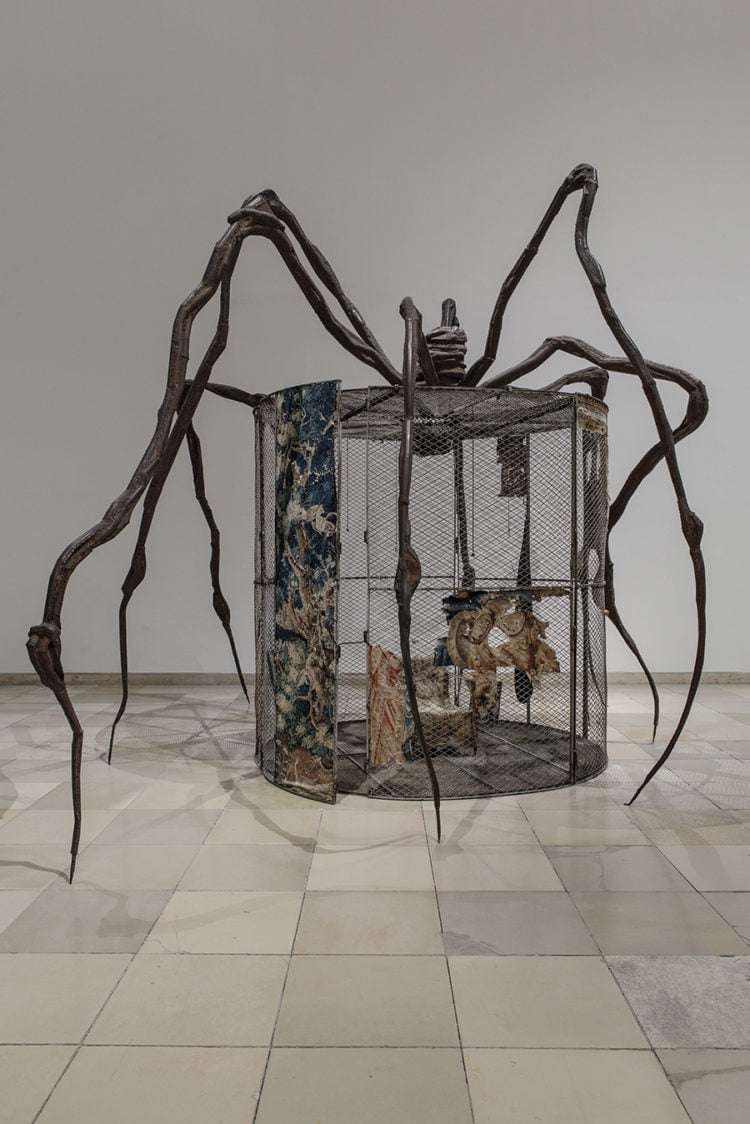
Spider, 1997 (steel, tapestry, wood, glass, fabric, rubber, silver, gold, and bone)
It is a great misfortune, believe you me, to have a father who laughs at you, who relishes making jokes at your expense. Though in fact he isn’t really making anything since the jokes he tells at the dinner table whether guests are there or not are the same jokes day in day out, year after year. There is nothing original about them and they were never funny in the first place. And it is probably that, being able to provoke you with the same crummy old jokes over and over, that makes him laugh so much. The same old joke yet again and look, hahaha, it has hit home—again! It never fails to provoke you and you are so funny when you are provoked. You crumple and frown and he laughs, you jump to your feet and indignantly protest and he laughs, you pretend you can’t hear him, that you have more important things on your mind, and he laughs. It doesn’t matter what you do or do not do, he’ll interpret it as a reaction to his provocation and be demonstrably victorious. It is completely enraging, the way this disgusting show-off thinks he’s got the better of you with that same old joke yet again. Look at him, laughing his head off, it’s disgusting, it’s despicable—even when you do nothing you are in fact, as far as he is concerned, trying your hardest to show him that you are mature and unfazed, and trying to appear unprovoked makes him laugh harder and louder than anything else in the world. You can’t get free of him. Is this why he does it? To remind you time and again that he is the center of your life, and everything you do—good, bad, or indifferent—is always and merely a reaction to him? Yes, of course that’s why he does it: it’s a form of control. He would object to that, put a hand on his heart and insist that he is only playing, but no one else is laughing. No, he is not a fun guy, he is a control freak who wants to keep you in your place. The place he has with good grace assigned you, a place he knows the shape and scope of, a place that does not challenge or encroach upon his. Occasionally you felt that you had it in you to achieve something worthwhile, that you would get somewhere, somewhere your interests and accomplishments would be recognized and encouraged, somewhere that enabled you to be a young woman with a life of her own. And then the gibes would come, the routine mocking, distorting all those small triumphs and the reasonable hopes that issued from them, so that they would seem like futile acts of rebellion, a childish backlash, or else foolish female attention-seeking nonsense. One day you are wearing a fur wrap and your father looks at you in it and says: “You bought that little fur jacket? Couldn’t you afford the whole coat?” Years later, while taking care of your clothes, you are suddenly “seized by this fury toward the blouses, which seemed short by half.” The memory of your father’s spiteful comment has come back to you, how he saw your fur as a cheap thing, a coat cut in two. You imagine the coat that would have pleased him, long and flowing, and you want to take all the blouses you are holding and throw them out: “I wanted to be whole.” Again and again his scornful remarks cut you in half, again and again his laughter pulls the rug from under you. No wonder you developed a fear of falling. How can you get a foothold in life when your own father, the very man you look to for guidance and support, refuses as a matter of principle to take you seriously? You go away. You leave. You stood your ground and then you couldn’t stand it anymore. You left and everything else stayed. And it haunts you, for the rest of your life everything you left behind haunts you.
Pain is an old thing. It lies there all the time. In the pit of my stomach. Languorously vigilant. One eye open. Now and then something prods it, throws it a bone, and the bilious feeling I experience is surely its dry fuzzy tail flipping from side to side. Beneath its paws are a lot of nebulous questions. They’ve been there for years, and I ought to go in and get them, arrange them properly in the clear light of day, but I don’t, I leave them to rot in the dark, but they don’t rot, and I am very cowardly because I don’t give them the attention they need in order to develop, and this refusal feeds the pain, makes it heavier, makes it sit heavier and heavier in the pit of my stomach. On occasion, such as a few days ago, I can feel them trying to substantiate themselves and that is painful. I don’t want them to acquire any kind of coherence because then they will confront me and I am a coward and couldn’t bear that. She was not afraid of questions. Or maybe she was and articulated them anyway. So many questions. As if she were in constant dialogue with herself. Perhaps she couldn’t fend them off:
1 What is it you want?
2 Do you know what it is?
3 Is it possible? no, why not
4 Are you looking for substitute? why?
5 Which one?
6 What is the Relation of the substitute to the What
7 What comes in between? death? impossible
8 You better know the answer to these questions otherwise a/ you are wasting your time b/ you are heading for a disappointment followed by depression.
On this loose-leaf page from 1965, Bourgeois takes hold of the questions, wrestles them into order, 1, 2, 3, moves through them, to their logical conclusions, a and b, like a formula. “Connais-toi toi-même,” she said, referring to Montaigne: “He meant that the only useful approach to life is to know yourself.” Not knowing made her anxious and fearful and she did not want to live a life limited by anxiety and controlled by fear, that is very clear to me and it has also become very clear to me that I live a life that is limited by anxiety and controlled by fear. I’ve been lying so well and living quite convincingly as if that weren’t the case, but last week’s bolt from the blue caused a sizable rupture and I realize I am full of shit really and I don’t know the first thing, or indeed any of the things after it, I don’t understand at all why my life is the way it is, I don’t think I have chosen anything, I don’t think I have been guided by internal forces one bit, yet I’ll sit there and say, over and over, that I have been, when actually I am a mess that is full of shit but perhaps I am only writing that because it feels dramatic and gratifying, as if I’m really expressing something, because actually I am angry, I am angry because it is frustrating, trying to understand, trying to be completely honest, trying to express anything with any certainty is impossible and that is very frustrating, I don’t even know whether to trust my feelings, I like being dramatic, I like the way it feels, so how trustworthy are my feelings, perhaps I distort all of my feelings, heighten them, so that I can feel dramatic, and by the way the rain is beating down on the skylight just above, absolutely beating down and now I see a tiny stone, small hard icy stones in June are beating down just there above my head and that is very dramatic and why do I like feeling dramatic, what does feeling dramatic even mean, it means I am a furnace, eternal powers course through me, my whole body feels potent and invincible, my glance alone could shatter anything it fell upon, I transcend all the questions, I feel absolutely wild and my hands have come to life.
I saw her hands. I saw them in Whitechapel exactly a week after I visited the Hayward. I hadn’t gone to the Whitechapel Gallery to see them. I didn’t know they were there. I didn’t know that any part of her would be there. The exhibition was big and brought together the work of many artists you rarely see in the same space. It was a last-minute visit. I was heading to the airport immediately afterward. I bought my ticket at the desk and went in still holding it and there on the left were three hands. Her hand—young, a child’s—placed softly upon two elegant outstretched hands that I understood to be her mother’s hands. Is this little hand preparing to let go? Are the mother’s slightly tilted hands bouncing the little hand very gently, preparing it to take flight, coaxing the little hand up and away, as if it were a small nervous bird? And where is the child’s other hand? Is it tied behind her back? At what point in her life did Louise Bourgeois’s hands become a pair? Her hand, her mother’s hands; the work they made between them; the touching, the repairing; the letting go. There they were, the missing piece, in pink marble. Marble! I don’t know how she did it, from where she found the strength. Hacking away at a rock when I can barely lift a pen.
“The subject of pain is the business I am in,” she once said. It is customarily supposed that pain is a great catalyst for creativity, since pain produces an overflow of emotion that must surely galvanize artistic expression. But pain is more than and less than emotional excess. It is a grueling existential experience and is therefore one of the most difficult human situations to express. Not least because it collapses time, and foments rigorous questions that devastate and liberate in equal measure. Pain, for Bourgeois, wasn’t about being “raw,” and making work wasn’t about “catharsis.” How I hate and loathe and despise both of those terms, for the way that they imply that art motivated by emotion is formally haphazard, a spilling of one’s guts. While Bourgeois openly acknowledged the strong emotional impulse that motivated all of her work, she also stressed, again and again, the centrality of its formal qualities. “The two things have to go together,” she said, adding that “the form has to be absolutely strict and pure.” Bourgeois understood that pain is a fundamental and unavoidable condition of life, yet her art did not strive to offer any “remedies or excuses” that might help it go away or lessen its intensity—as far as she was concerned pain was here to stay. If it was “useful” to her in any way it was arguably because the profound disquietude it caused her made her feel unfinished, incomplete, thus preventing her from lapsing into passivity—a deadly condition she seemed to dread even more than falling. Pain kept her searching, doubting, questioning—continuous processes that meant that for all her long life she was in a perpetual state of becoming. Included in the Hayward exhibition and catalogue are drawn and sculpted depictions of pregnant women and women giving birth. Maternity was a theme that preoccupied Bourgeois in the later years of her life, and significantly she said that this motif was not a reference to the birth of her children, but to her own birth. Nascent and mercurial aren’t qualities one would typically associate with sculpture, yet many of hers couldn’t be described better (though not the pole piece with hanging garments—unbearably static and marooned). I don’t mean to suggest that they appear unfinished or incomplete, not at all—it’s more that they seem like they might alter, that if you turn away they’ll change, or even disappear altogether. They look . . . unsettled. Perhaps this strange wavering quality accounts for the petulant frustration I experienced in the Hayward. The nagging sense of anticipation, the sudden anger, the irritation toward other people, the feeling that the missing piece was just around the corner. The anxious desire to see her hands and have something to hold on to. It was as if I was observing the adult world through the eyes of a perceptive child and couldn’t quite grasp it. As such I am unlikely to ever forget what I saw, just as there was so much that Louise Bourgeois was unable to put behind her.


